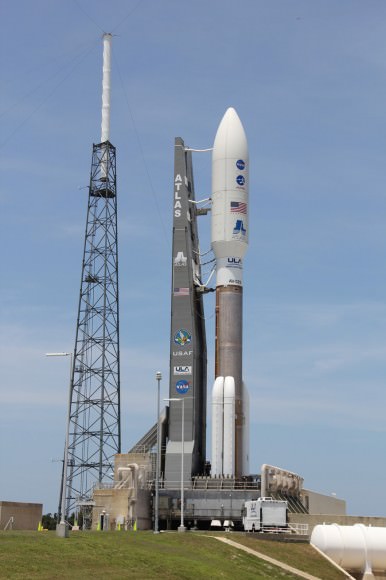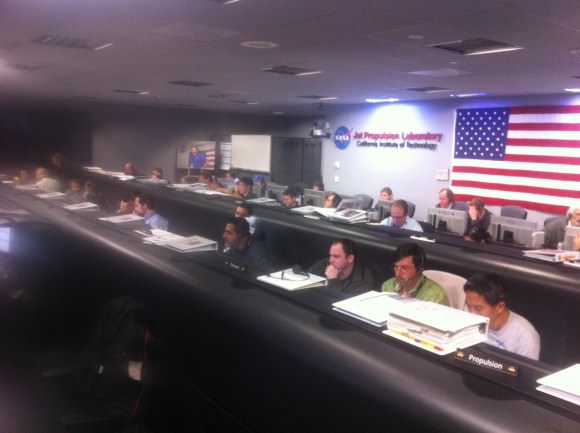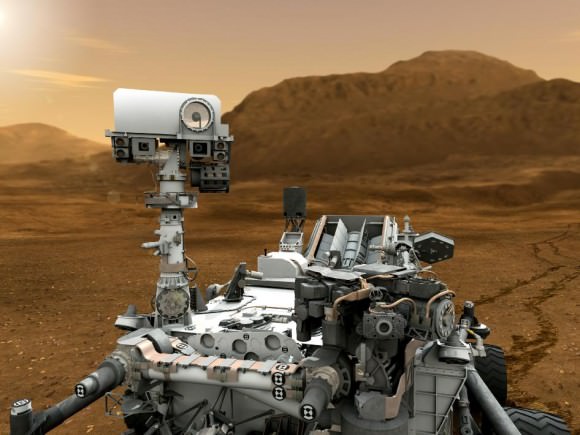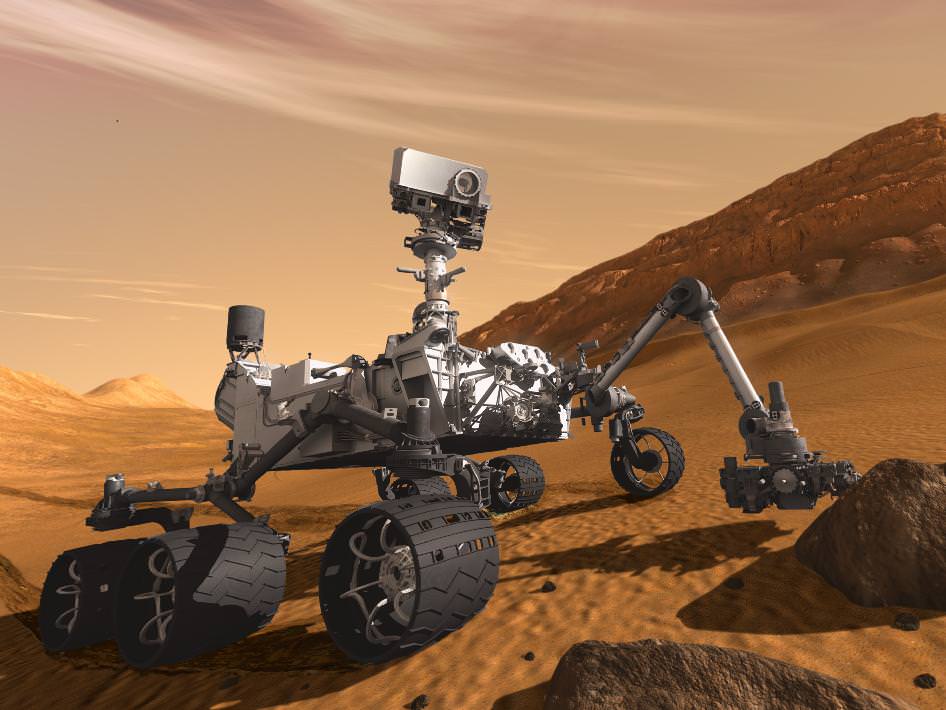[/caption]
NASA’s Curiosity Mars rover, the most technologically complex and scientifically capable robot built by humans to explore the surface of another celestial body, is poised to liftoff on Nov. 26 and will enable a quantum leap in mankind’s pursuit of Martian microbes and signatures of life beyond Earth.
“The Mars Science Lab and the rover Curiosity is ‘locked and loaded’, ready for final countdown on Saturday’s launch to Mars,” said Colleen Hartman, assistant associate administrator in NASA’s Science Mission Directorate, at a pre-launch media briefing at the Kennedy Space Center (KSC).
The $2.5 Billion robotic explorer remains on track for an on time liftoff aboard a United Launch Alliance Atlas V rocket at 10:02 a.m. on Nov. 26 from Space Launch Complex 41 at Cape Canaveral Air Force Station in Florida.

NASA managers and spacecraft contractors gave the “Go-Ahead” for proceeding towards Saturday’s launch at the Launch Readiness Review on Wednesday, Nov. 23. The next milestone is to move the Atlas V rocket 1800 ft. from its preparation and assembly gantry inside the Vertical Integration Facility at the Cape.
“We plan on rolling the vehicle out of the Vertical Integration Facility on Friday morning [Nov. 25] ,” said NASA Launch Director Omar Baez at the briefing. “We should be on the way to the pad by 8 a.m.”
The launch window on Nov. 26 is open until 11:14 a.m. and the current weather prognosis is favorable with chances rated at 70 percent “GO”.
“The final launch rehearsal – using the real vehicle ! – went perfectly, said NASA Mars manager Rob Manning, in an exclusive interview with Universe Today. Manning is the Curiosity Chief Engineer at NASA’s Jet Propulsion Laboratory in Pasadena, Calif.
“I was happy.”
“The folks at KSCs Payload Handling Facility and at JPL’s cruise mission support area (CMSA) – normally a boisterous bunch – worked quietly and professionally thru to T-4 minutes and a simulated fake hold followed by a restart and a recycle (shut down) due to a sail boat floating too close to the range,” Manning told me.

Readers may recall that NASA’s JUNO Jupiter orbiter launch in August was delayed by an hour when an errant boat sailed into the Atlantic Ocean exclusion zone.
“This rover, Curiosity rover, is really a rover on steroids. It’s an order of magnitude more capable than anything we have ever launched to any planet in the solar system,” said Hartman.
“It will go longer, it will discover more than we can possibly imagine.”

Curiosity is locked atop the powerful Alliance Atlas V rocket that will propel the 1 ton behemoth on an eight and one half month interplanetary cruise from the alligator filled swamps of the Florida Space Coast to a layered mountain inside Gale Crater on Mars where liquid water once flowed and Martian microbes may once have thrived.
Curiosity is loaded inside the largest aeroshell ever built and that will shield her from the extreme temperatures and intense buffeting friction she’ll suffer while plummeting into the Martian atmosphere at 13,000 MPH (5,900 m/s) upon arrival at the Red Planet in August 2012.
The Curiosity Mars Science Lab (MSL) rover is the most ambitious mission ever sent to Mars and is equipped with a powerful 75 kilogram (165 pounds) array of 10 state-of-the-art science instruments weighing 15 times as much as its predecessor’s science payloads.
Curiosity measures 3 meters (10 ft) in length and weighs 900 kg (2000 pounds), nearly twice the size and five times as heavy as NASA’s prior set of twin robogirls – Spirit and Opportunity.
The science team selected Gale crater as the landing site because it exhibits exposures of clays and hydrated sulfate minerals that formed in the presence of liquid water billions of years ago, indicating a wet history on ancient Mars that could potentially support the genesis of microbial life forms. Water is an essential prerequisite for life as we know it.
Gale Crater is 154 km (96 mi) in diameter and dominated by a layered mountain rising some 5 km (3 mi) above the crater floor.

Gale Crater, where the rover Curiosity of NASA's Mars Science Laboratory mission will land in August 2012, contains a mountain rising from the crater floor. This oblique view of Gale Crater, looking toward the southeast, is an artist's impression using two-fold vertical exaggeration to emphasize the area's topography. Curiosity's landing site is on the crater floor northeast of the mountain. The crater's diameter is 96 miles (154 kilometers). The image combines elevation data from the High Resolution Stereo Camera on the European Space Agency's Mars Express orbiter, image data from the Context Camera on NASA's Mars Reconnaissance Orbiter, and color information from Viking Orbiter imagery.
Credit: NASA/JPL-Caltech/ESA/DLR/FU Berlin/MSSS
The car sized rover is being targeted with a first of its kind precision rocket powered descent system to touchdown inside a landing ellipse some 20 by 25 kilometers (12.4 miles by 15.5 miles) wide and astride the towering mountain at a location in the northern region of Gale.
Curiosity’s goal is to search the crater floor and nearby mountain – half the height of Mt. Everest – for the ingredients of life, including water and the organic molecules that we are all composed of.
The robot will deploy its 7 foot long arm to collect soil and rock samples to assess their composition and determine if any organic materials are present – organics have not previously been detected on Mars.
Curiosity will also vaporize rocks with a laser to determine which elements are present, look for subsurface water in the form of hydrogen, and assess the weather and radiation environments
“After the rocket powered descent, the Sky-Crane maneuver deploys the rover and we land on the mobility system, said Pete Theisinger, MSL project manager from the Jet Propulsion Laboratory in Pasadena, Calif., at the briefing.
The rover will rover about 20 kilometers in the first year. Curiosity has no life limiting constraints. The longevity depends on the health of the rovers components and instruments.
“We’ve had our normal challenges and hiccups that we have in these kinds of major operations, but things have gone extremely smoothly and we’re fully prepared to go on Saturday morning. We hope that the weather cooperates, said Theisinger
Missions to Mars are exceedingly difficult and have been a death trap for many orbiters and landers.
“Mars really is the Bermuda Triangle of the solar system,” said Hartman. “It’s the ‘death planet,’ and the United States of America is the only nation in the world that has ever landed and driven robotic explorers on the surface of Mars. And now we’re set to do it again.”
Complete Coverage of Curiosity – NASA’s Next Mars Rover launching 26 Nov. 2011
Read continuing features about Curiosity by Ken Kremer starting here:
Science Rich Gale Crater and NASA’s Curiosity Mars Rover in Glorious 3-D – Touchdown in a Habitable Zone
Curiosity Powered Up for Martian Voyage on Nov. 26 – Exclusive Message from Chief Engineer Rob Manning
NASA’s Curiosity Set to Search for Signs of Martian Life
Curiosity Rover Bolted to Atlas Rocket – In Search of Martian Microbial Habitats
Closing the Clamshell on a Martian Curiosity
Curiosity Buttoned Up for Martian Voyage in Search of Life’s Ingredients
Assembling Curiosity’s Rocket to Mars
Encapsulating Curiosity for Martian Flight Test
Dramatic New NASA Animation Depicts Next Mars Rover in Action
Packing a Mars Rover for the Trip to Florida; Time Lapse Video
Test Roving NASA’s Curiosity on Earth


From a book review in “Sky & Telescope” (Oct. 2002, p. 63): “The author [of BAD ASTRONOMY: MISCONCEPTIONS AND MISUSES REVEALED, FROM ASTROLOGY TO THE MOON LANDING ‘HOAX’, Philip Plait, John Wiley & Sons, 2002)] also sets the record straight on the way some perfectly valid scientific terms have been distorted by their use in everyday language. Examples of this include ‘light-years ahead’ (light-years measure distance, not time), ‘meteoric rise’ (would be characterized by a sudden burnout), ‘quantum leap’ (actually a very tiny jump), and ‘dark side of the Moon’ (‘far side’ is what’s usually meant). Note to self: Excise these from vocabulary immediately.”
There seems to be quite a spat of unlucky metaphor in this piece. Oh well, I need to take my time over morning coffee today anyway:
I don’t know which etymology Plait provides. But I had always construed this as a folk science suggestion on quantum mechanics. Perhaps as a “crokoduck” mixture between transitions between energy levels and quantum tunneling between spatial positions with an energy barrier in between.
Neither process would be instantaneous but obey relativity. As I remember it, transition times took a long time to be resolved in atoms, and quantum tunneling speeds are but lately tentatively measured. (Both consistent with relativity.)
Other putative meanings would be as an expression for stochasticity in movement, as in Brownian molecular motion, or uncertainty in position. But again obeying relativity, as all of QM does, not suggesting immediacy in some achievement.
In any case, on these grounds I have to agree with Plait.
But while we are at it, other metaphor here should perhaps be excised from common vocabulary as well:
This popular expression supports an unfortunate and at times dangerous use of steroids for muscle mass. While steroids have their biological and medical uses (as hormones), they have a series of health and social drawbacks.
If you want to be punny, the rover is “well built”, “massive”, “radiating with energy”, “a road warrior” [it totally should have been named Mad Max: “Mad Max’s Mars Memoirs” would be a hit title for a book], et cetera.
This is unfair to many basketball players.
Wikipedia gives some stats:
“At the professional level, most male players are above 6 feet 3 inches (1.91 m) and most women above 5 feet 7 inches (1.70 m). Guards, for whom physical coordination and ball-handling skills are crucial, tend to be the smallest players. Almost all forwards in the men’s pro leagues are 6 feet 6 inches (1.98 m) or taller. Most centers are over 6 feet 10 inches (2.08 m) tall. According to a survey given to all NBA teams, the average height of all NBA players is just under 6 feet 7 inches (2.01 m),”
Since the average height of US males is ~ 1.76 cm [1999-2002], most men beat some of the female basketball players for height.
Seems US male pro players corresponds to the usage of the metaphor. I can’t get to useful statistics, but basketball seems pretty world wide (most associations older than US’s), so I would wonder how the metaphor holds up in general.
“In any case, on these grounds I have to agree with Plait.”
That makes it sound like it’s a matter of opinion, which it really isn’t. Even in the case of the largest atom, if an electron jumps from the lowest level or “fundamental state” to the outermost level, it will have moved so little, in our, human, terms, that it’s like it had moved not at all. The photon that flies away when the electron falls back to its previous level does make an astonishing leap, but that’s not a quantum leap…or is it???
Anyway, it would’ve been better if the author of the report had used, not such a worn out expression, but a forceful, imaginative, creative and original one, like, for example, “a giant step for (hu)mankind”, which I invented a few minutes ago, unless it lay there buried at a subconscious level for years, ever since I saw it somewhere, but I doubt it.
Luckily I don’t tend to nail biting. This will be quite some exercise in patience.
I had to check that, since the construction didn’t look familiar to me.
Indeed, it seems TFD suggests the verb is rove rather than rover. But language evolves, is this a common expression in planetary science circles?
No, I think it’s just a typo.
Then again, people have been known to verb* some nouns in casual language.
* verb v. to make into a verb
This report has the MSL as 900kg, while the report about the navigation has the MSL at 4 Tonnes. Which is it? 🙂
Keep us updated so we can watch this real time. Maybe a live stream on UT would be a good idea.
LC
2.5 billion? … Should have cost 300 million tops